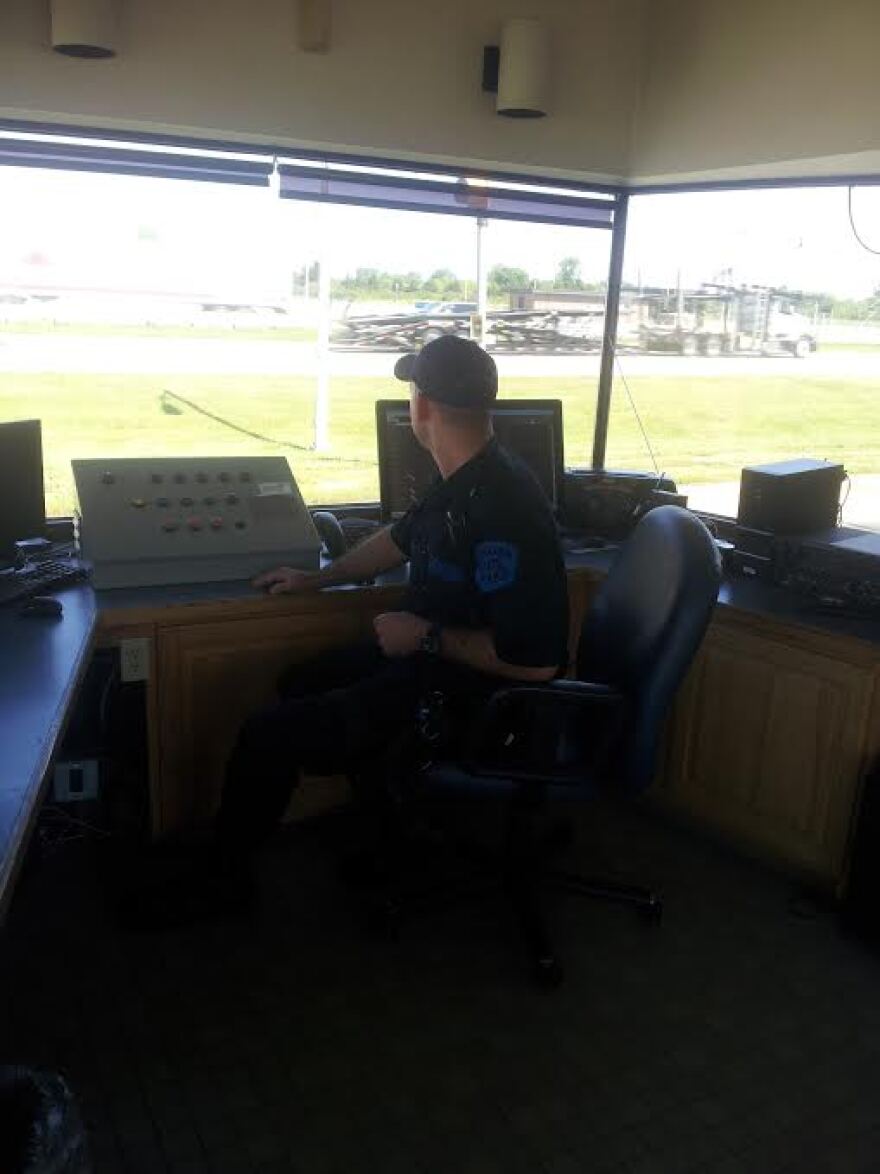There’s a lot of talk (though as of yet, no action) about a long-term solution for fixing Michigan’s crumbling roads.
One question that comes up a lot in the surrounding debate: What role do all those heavy trucks play, and what should we do about them?
That’s the question at the heart of this edition of MI Curious, Michigan Radio’s series investigating listener questions about our state.
Michigan Radio’s Sarah Cwiek looked into this question from Ethan Winter, who asked: “Why are all the weigh stations always closed?”
The existing resources: 14 weigh stations, 102 enforcement officers, a lot of trucks
Ok, Ethan Winter knows the weigh stations aren’t actually closed all the time. But sometimes it seems like it.
Winter is 30 years old. He lives in Kalamazoo. And he makes the occasional drive to Chicago along I-94.
During one recent trip, Winter saw the sign for the weigh station in New Buffalo, near the Indiana border. It was closed.
“That made me think the number of times I had seen it open over the years,” said Winter. “And I realized I could count the number of times it was open on one hand.”
This was during the big debate over Proposal 1. You might recall that state ballot measure that would have raised about $1.2 billion in annual road funding? The one that failed miserably?
So seeing that “closed” sign made Ethan Winter wonder: “Are we using all the resources we currently have to limit the damage done by large trucks to our roads?”
Weigh stations are the primary mechanism we have for policing the trucks on our roads, and making sure they’re in compliance with a whole host of federal and state standards.
Right now, there are 102 Michigan State Police officers doing commercial vehicle enforcement across 14 weigh stations statewide.
It’s a busy beat. Though commercial traffic is just rebounding after a dip following the 2008 economic downturn, freight traffic has surged since the implementation of NAFTA and increased international trade.
That means more trucks on the road, especially in border states like Michigan. $52 billion worth of goods crossed the U.S.-Canada border in June 2015 alone.
The vast majority of that freight — in Michigan, about two-thirds of it — is carried by truck.
Policing trucks in one of the nation’s truck hotspots
The state’s busiest weigh station is on I-75 just south of Monroe. Just how busy is it?
“This section of I-75 between Toledo and Detroit is the second-busiest section of roadway for commercial traffic in the United States,” said Michigan State Police Lieutenant Steve Pascoe, 1st district commanding officer with the MSP’s commercial vehicle enforcement division. “We see up to 700 trucks an hour come over our scales here.”
I met Pascoe at the Monroe weigh station on the northbound side of the freeway. Coincidentally, the station on the southbound side was closed that day.
When I asked why, Pascoe said it’s because an officer was out with an injury. Stuff like that happens. Plus, he only has so many officers to work with.
“When I started in 1998, we had 21 motor carrier officers stationed at Monroe,” Pascoe said. “Right now we have 12.”
https://www.youtube.com/watch?t=121&v=fIsqWrZrWq0
As we’re talking, motor carrier officer Nathan Daugherty is watching a constant stream of trucks rumble past at 30 miles an hour. He’s also got several computer panels flashing at him.
“As they’re going over right here, there’s two metal plates in the ground," said Daugherty. "That’s like a weigh-in motion scale. And what that does is it shows up on the computer screen there, approximately how much they weigh.”
Other sensors pick up more information: like how fast the truck is going, and how many axles it has. Daugherty says all that gives him a good sense of whether a truck is in compliance.
But he also has to do a quick visual check for a whole lot of other stuff, from license plates to windshield obstructions. Daugherty admits it’s a lot to process all at once.
“You need a routine, but at the same time, you can’t be stuck in that routine to check each truck,” he said.
Daugherty gets a hand from technology. The computer flags some potentially overweight trucks, and flashes a signal ordering them around back. There’s another set of scales back there for a stationary weigh-in — and if necessary, a complete inspection.

But motor carrier officers can weigh trucks while on road patrol too. They're equipped with portable scales, and the same kind of "weigh-in-motion" sensors used at the weigh stations.
Lt. Pascoe says even if a weigh station is closed, that doesn’t mean no one is watching.
“We can do everything out of our cars that we can do here at this weigh station,” Pascoe said.
“That money … does not go to our roads”
All told, carrier officers issued more than 38,000 citations in 2014, although just over 10% of those were for overweight violations.
That generated about $4.5 million in fines. But here’s the thing about that money…
“That money collected goes to the libraries,” said State Rep. Marilyn Lane, a Macomb County Democrat. “It does not go to our roads.”
Lane, vice chair of the House Transportation Committee, thinks that law needs to change. She thinks another one should too: the World War Two-era state law that allows trucks up to 164,000 pounds on Michigan roads.
That’s the highest weight limit in the nation, and more than twice the federal standard.
On top of that, Michigan allows so-called “super loads” exceeding that amount — for a flat additional $50 a year.
Lane thinks all that needs to change. “We need to immediately, if nothing else, reduce our weights to 80,000 (pounds), and start preserving and protecting our pavement immediately,” she said.
But it turns out this issue of how much heavy trucks damage Michigan roads — and even how to measure that — is an issue of much debate.
The Michigan Department of Transportation contends it's weight load per axle that matters, not gross truck weights.
And, the agency argues that if gross vehicle weights were lowered, it would result in more trucks on the road — and more road damage.
MDOT also notes that in Michigan, trucks pay greater per-mile road user fees (in fuel taxes and registration costs) than cars do.
There’s some dispute over those numbers, though, at least on the national level.
Engineers agree that commercial trucks simply do cause more road damage than other vehicles — with one 80,000 pound truck the equivalent of roughly 5-10,000 cars, depending on which government study you consult — and that damage tends to increase exponentially as trucks get heavier.
A recent Congressional Budget Office study also found that trucks cause roughly 74-96 cents per ton-mile in “unpriced external costs” when it comes to pavement damage.
Bad news and (a little) good news
Whatever the engineering truth of the matter, the idea of lowering truck weight limits is a fairly popular one with the public.
But whenever it comes up for a vote in Lansing, it fails — most recently in the State Senate late last year.
Why is that? State Rep. Lane points to lobbying from some of the state’s biggest industries, and two in particular: agriculture and logging.
“They’re the ones that carry a lot of the most weight,” Lane said. “So you kind of just have to follow where the big strong voice is.”
So when the legislature again tried, and failed, to get a road funding package earlier this summer, truck weights weren’t even up for discussion.
At that time, State House Speaker Kevin Cotter said it was all about getting enough votes.
“Those issues are a bit controversial,” Cotter said. “It’s ultimately [what] can we get 56 votes behind?”
Given the technical and political controversy, trucks and truck weights aren’t likely to be part of the roads funding conversation for at least the next two years.
But things might get a little better out on the highways.
The Michigan State Police commercial enforcement division hopes to start training 15-20 new motor carrier officers this fall. That means you could start seeing a few more stations displaying an “open” sign soon.





